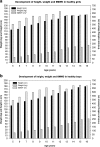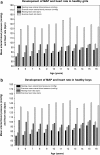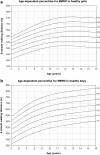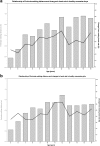Reference values for the 6-minute walk test in healthy children and adolescents in Switzerland
- PMID: 23915140
- PMCID: PMC3750631
- DOI: 10.1186/1471-2466-13-49
Reference values for the 6-minute walk test in healthy children and adolescents in Switzerland
Abstract
Background: The six-minute walk test (6MWT) is a simple, low tech, safe and well established, self-paced assessment tool to quantify functional exercise capacity in adults. The definition of normal 6MWT in children is especially demanding since not only parameters like height, weight and ethnical background influence the measurement, but may be as crucial as age and the developmental stage. The aim of this study is establishing reference values for the 6MWT in healthy children and adolescents in Switzerland and to investigate the influence of age, anthropometrics, heart rate, blood pressure and physical activity on the distance walked.
Methods: Children and adolescents between 5-17 years performed a 6MWT. Short questionnaire assessments about their health state and physical activities. anthropometrics and vitals were measured before and after a 6-minute walk test and were previously defined as secondary outcomes.
Results: Age, height, weight and the heart rate after the 6MWT all predicted the distance walked according to different regression models: age was the best single predictor and mostly influenced walk distance in younger age, anthropometrics were more important in adolescents and females. Heart rate after the 6MWT was an important distance predictor in addition to age and outreached anthropometrics in the majority of subgroups assessed.
Conclusions: The 6MWT in children and adolescents is feasible and practical. The 6MWT distance depends mainly on age; however, heart rate after the 6MWT, height and weight significantly add information and should be taken into account mainly in adolescents. Reference equations allow predicting 6-minute walk test distance and may help to better assess and compare outcomes in young patients with cardiovascular and respiratory diseases and are highly warranted for different populations.
Figures





References
Publication types
MeSH terms
LinkOut - more resources
Full Text Sources
Other Literature Sources
Medical

